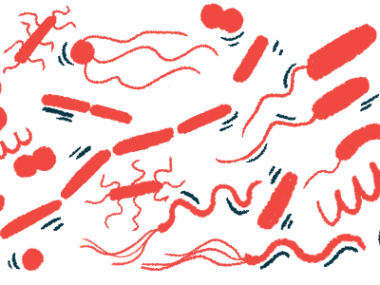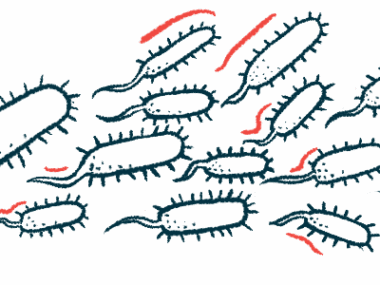In early P. aeruginosa infections in CF, LasB enzyme may be target
Novel LasB therapies likely to work best before chronic disease onset
Written by |

LasB, an enzyme that promotes Pseudomonas aeruginosa infections in the lungs of people with cystic fibrosis (CF), is significantly more active in the early stages of infection with the bacteria, known more simply as P. aeruginosa, a study revealed.
These findings suggest that therapies targeting LasB may be most effective for the treatment of early-stage infections in CF patients, the researchers concluded.
Specifically, the scientists noted that their “findings show a correlation between elevated LasB activity in P. aeruginosa isolates [samples] and early-stage infection in CF patients.”
“Hence, it is this patient group, prior to the onset of chronic disease, that may benefit most from novel therapies targeting LasB,” the team wrote.
The study, “Higher levels of Pseudomonas aeruginosa LasB elastase expression are associated with early-stage infection in cystic fibrosis patients,” was published in the journal Scientific Reports.
First step: Determining if LasB is tied to early or late infection stage
P. aeruginosa is a bacteria that, while commonly found in the environment, represents a major contributor to progressive lung damage in people with CF.
Its success in infecting the lungs comes from its ability to produce a large number of virulence factors — secreted molecules that help bacteria colonize tissue, obtain nutrients, and evade or suppress a person’s immune response.
LasB elastase is a key virulence factor for P. aeruginosa. Secreted in high amounts, this enzyme can digest various proteins and promote tissue damage, inflammation, and immune suppression. As such, the enzyme has been identified as a potential anti-virulence treatment target either as an alternative or in addition to antibiotics.
To better understand how such a therapy could help CF patients, scientists in France measured LasB production and activity in bacteria samples collected from early versus established, or chronic, stages of P. aeruginosa infection.
“We sought to differentiate the P. aeruginosa isolates from early versus established stages of infection in CF patients and to determine if LasB was associated with either stage,” the scientists wrote.
A total of 255 P. aeruginosa strains were isolated from sputum samples collected from 70 CF patients. These patients had a median age of 12, and their infection status was classified as either chronic, intermittent, or new. Those with chronic status had P. aeruginosa found in more than half of their sputum samples in the prior year. Individuals categorized as intermittent had 50% or fewer samples with P. aeruginosa in the prior year, while those classified as new had the bacteria isolated for the first time in the sample provided for this study.
Genetic sequencing of the LasB gene that encodes the LasB enzyme found nine variants or DNA changes among all of the P. aeruginosa samples. Of them, three accounted for 94.5% of the isolated bacteria.
LasB activity, as measured by the breakdown of a fluorescent LasB substrate, was detected in 176 of the samples (69%), but those with chronic infections showed significantly lower LasB activity than those with new infections.
An initial statistical analysis could not identify any clinical factors that discriminated between the three infection groups — new, intermittent, and chronic — that correlated with LasB activity. After removing these groups from the calculation, however, a clustering analysis revealed two distinct classes of infection: early and established infection.
Findings shed new light on P. aeruginosa infections in CF
In the new analysis, people in the early infection class more frequently had better lung function, higher LasB activity, fast bacteria growth, and susceptibility to the antibiotic tobramycin. Here, P. aeruginosa bacteria also frequently grew as large green colonies.
In comparison, the established infection group more commonly had older age, a longer time since the first infection, P. aeruginosa infection within the last three months, and singular infections. These P. aeruginosa bacteria grew as small white colonies.
Finally, a genetic analysis of isolates collected from the same patients in the same original classification group (new, intermittent, and chronic) identified those with single or co-infections.
In the single infection group, comprising 48% of the patients, all isolates collected from a single patient shared the same DNA sequence type. Still, some differences were found in the LasB gene and LasB production, supporting the “occurrence of microevolution of P. aeruginosa to adapt to the CF lung environment,” the team wrote.
In the co-infection group, which included the other 52%, isolates from the same patient had different DNA sequence types. According to the researchers, this indicated “either the presence of multiple strains within the lungs at the same time or sequential infections with different strains of P. aeruginosa.”
This group had more patients originally defined as having an initial intermittent or chronic infection than the single infection group (91% vs. 70%).
These findings suggest that, in CF patients, anti-virulence therapies targeting … LasB … may be most effective for the treatment of early-stage infections, prior to the establishment of chronicity.
“Our data indicate that P. aeruginosa isolates from CF patients express higher levels of LasB elastase activity during the early stages of infection,” the scientists concluded.
“These findings suggest that, in CF patients, anti-virulence therapies targeting the LasB elastase may be most effective for the treatment of early-stage infections, prior to the establishment of chronicity,” they wrote.








